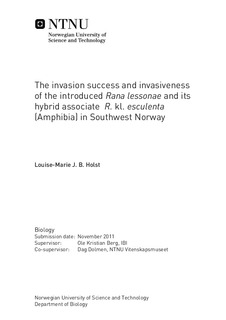The invasion success and invasiveness of the introduced Rana lessonae and its hybrid associate R. kl. esculenta (Amphibia) in Southwest Norway
Master thesis
Permanent lenke
http://hdl.handle.net/11250/2394252Utgivelsesdato
2011Metadata
Vis full innførselSamlinger
- Institutt for biologi [2514]
Sammendrag
In 2003, congeners of the green frog complex, R. lessonae and R. kl. esculenta, were intentionally and illegally introduced to Finnøy, an island in Southwest Norway. All freshwater localities on the island were investigated for three consecutive years from 2009 to 2011 to study the aliens? establishment, dispersal and habitat requirements.
In 2009, the frogs were confined to the northern half of the island and present in approximately 30% of all the freshwater localities. The population as a whole expanded its geographical range every year. R. kl. esculenta dispersed further and faster than R. lessonae. In 2011, R. lessonae and R. kl. esculenta were present throughout the study area, in 51% and 62% of the localities, respectively. Successful reproduction occurred in half of the occupied localities.
The frogs displayed low habitat selectivity on Finnøy. Sun exposure was the strongest limiting factor on the probability of presence of both forms of frogs and reproduction. Other possible habitat requirements included distance to nearest forest edge, water colour, pH and aluminium concentration.
Freshwater localities on the mainland near Finnøy were investigated for habitat suitability in the likely, but unwanted event of secondary introductions. Two scenarios, based on different interpretations of the habitat requirements on Finnøy, predicted suitable breeding localities on the mainland.
The results show that the green frogs on Finnøy have had a formidable invasion success and high level of invasiveness and should be considered as a valid conservation problem in Norway.
